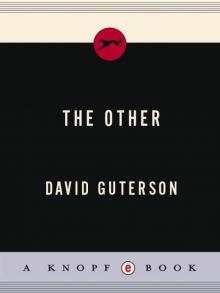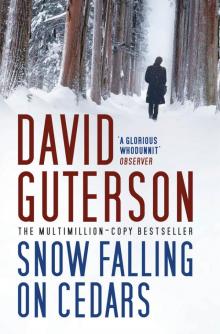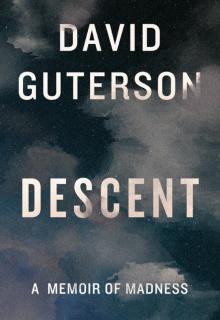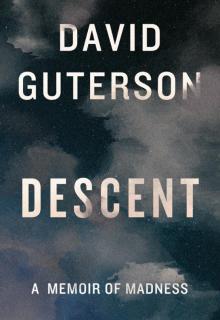- Home
- David Guterson
Snow Falling on Cedars
Snow Falling on Cedars Read online
SNOW FALLING
ON CEDARS
David Guterson
Contents
Cover
Title
Copyright
Dedication
Praise
Introduction
Acknowledgments
Chapter 1
Chapter 2
Chapter 3
Chapter 4
Chapter 5
Chapter 6
Chapter 7
Chapter 8
Chapter 9
Chapter 10
Chapter 11
Chapter 12
Chapter 13
Chapter 14
Chapter 15
Chapter 16
Chapter 17
Chapter 18
Chapter 19
Chapter 20
Chapter 21
Chapter 22
Chapter 23
Chapter 24
Chapter 25
Chapter 26
Chapter 27
Chapter 28
Chapter 29
Chapter 30
Chapter 31
Chapter 32
About the Book
About the Author
For Discussion
Bloomsbury Publishing, London, Berlin and New York
First published in Great Britain in 1995 by Bloomsbury Publishing Plc
36 Soho Square, London, W1D 3QY
This electronic edition published in 2010 by Bloomsbury Publishing Plc
Copyright © 1995 by David Guterson
Introduction copyright © 2007 by Nicholas Evans
The moral rights of the author and illustrator have been asserted
All rights reserved
You may not copy, distribute, transmit, reproduce or otherwise make available this publication (or any part of it) in any form, or by any means (including without limitation electronic, digital, optical, mechanical, photocopying, printing, recording or otherwise), without the prior written permission of the publisher. Any person who does any unauthorised act in relation to this publication may be liable to criminal prosecution and civil claims for damages
A CIP catalogue record for this book is available from the British Library
ISBN 9781408806760
www.bloomsbury.com/davidguterson
Visit www.bloomsbury.com to find out more about our authors and their books
You will find extracts, author interviews, author events and you can sign up for newsletters to be the first to hear about our latest releases and special offers
To my mother and father,
with gratitude
Praise for Snow Falling on Cedars
‘Snow Falling on Cedars is a vivid and spellbinding novel, made unforgettable by David Guterson’s mastery of detail and his wise and generous heart. I could not put this book down’ Colin Harrison, author of Bodies Electric
‘A beautifully written book, it is in essence a whodunnit, but is so rich a read that it far outstrips its form’ Scotland on Sunday
‘As much a clever thriller as a poetic evocation of a small community … a novel of both brilliant surface and fascinating depth’ Literary Review
‘An absorbing and beautiful work’ Guardian
‘Dramatic and suspenseful … Snow Falling on Cedars announces the emergence of a skilful writer’ Times Literary Supplement
‘Snow Falling on Cedars recalls the great morality fictions of the 19th century. By setting his novel in the fifties, Guterson permits himself to skirt the self-referential tropes, the knowing ironies, the supremacy of desire over personal morality, that have become axiomatic in much intelligent modern fiction. It is a risky gambit, but his haunting book is the richer for it’ Sunday Telegraph
‘Compelling … a flawlessly written first novel’ The New York Times
Introduction
Nicholas Evans
Ten years ago I was in Seattle, attending one of those so-called literary dinners where authors make speeches to plug their books. I’d just finished reading Snow Falling on Cedars for the first time and was in that bereaved limbo you enter when you’ve been captivated by a book and suddenly it’s over. The consolation that evening was that ‘local author’ David Guterson was going to be there too.
The place was packed with fans, all doubtless eager, as I was, to get their precious copy of his book personally inscribed. We expected him to transport us back to the strawberry fields and salmon-seething waters of San Piedro island. Instead, he took us to an altogether different world, the orchards of Washington State, delivering a witty and informal lecture about apple growers. It was a subject he’d been researching and soon he had us all entranced.
An hour later, he looked at his watch and, with a kind of boyish charm, said he was sorry but he would have to leave immediately or he’d miss the last ferry home. I got to shake his hand but never got my signed copy. What I did get, however, was a glimpse of what I believe helps make Snow Falling on Cedars so special: a searing intellect, a fascination with detail and a seemingly infinite compassion and curiosity about what it is to be human. The book business, like the movie business, increasingly likes to label things. Every new work, however original, has to belong to a genre. This extraordinary debut novel has thus been called a whodunnit, a thriller, a courtroom drama. It is all of those things but, in essence, none of them.
From the opening close-up of the man at the story’s centre, sitting with dignity in the courtroom where, like the jury, we will witness his trial for murder, we know something special is happening. The court itself, with its groaning, hissing radiators, its grey light, the smell of damp coats and boots, provides the structure of the story and becomes a kind of character itself: a living, listening, omniscient presence. Beyond its four tall, narrowly arched windows, we watch the snow fall. It is as if life on the island of San Piedro – and indeed time itself – has been suspended until a verdict is reached.
Most novelists attempt to convey a sense of place, but with Guterson we’re taken to a different level of knowledge. It soon becomes clear that we are in the hands not simply of a gifted storyteller but of a compulsive researcher. Whether it’s the intricacies of gill-netting salmon or of samurai swordsmanship, almost every page teaches us something new. But the detail is measured and never distracts from story or character. We get to know the island as if we have grown up there. We can smell the tang of netted salmon in the salt air, taste the freshly harvested strawberries, hear the drip of rain on the moss and fern of the forest floor.
Although the present tense of the story is on San Piedro in 1954, other places at other times are rendered just as vivid: the desert prison camp, with its stinking latrines and relentless sand-laced wind, where the island’s Japanese immigrants are interned after Pearl Harbor; the blood-washed beach in the South Pacific where as a young G.I., Ishmael Chambers – local reporter, spurned lover and our guide through the maze of half-truth, lies and prejudice uttered in the courthouse – is maimed in a poorly planned, heart-thumping, hellish assault.
Guterson’s handling of time is masterly. The transitions between present and past are seamless but we always know precisely where we are and through whose eyes we are watching the events unfold. With a fine economy, he opens up his characters’ lives and tells us their history, their passions and triumphs, the losses, dashed hopes and disillusionments that have shaped them into who they are. Even the most minor of these people, however tangential to the plot, is given his or her own journey, their souls etched, like characters in a Chekhov play, by some hidden yearning or thwarted ambition.
Ultimately, it has to be this very quality, the novel’s understanding of human nature, that has touched the hearts of the many millions who have read it. In particu
lar, it is the compassionate light its author sheds on how the seeds of racism are sown; on the way man and woman, parent and child, affect each other; on that exquisite pain we inflict on those we love, and who love us, the most.
I’m a slow reader and as I grow older and less patient, there is a test I’ve come to apply to whether a book has been worth reading. Has it, I ask myself, given me any new insight into the frenzied muddle and puzzle that life seems to be? Without wanting to be too grandiose about it, has it, in short, furthered my understanding of the human condition?
Every time I read Snow Falling on Cedars, the answer is an ever more resounding yes.
ACKNOWLEDGMENTS
I thank the many people who contributed to the writing of this book: Mike Hobbs at Harborview Hospital in Seattle, for his help with matters of forensic pathology; Phil McCrudden for taking me salmon fishing and for carefully reading a draft of the novel; Steve Shapiro for his insights about gill-netting; Leonard Hayashida for his gentle and precise commentary; Walt and Millie Woodward for their courage and conviction as owner-editors of the Bainbridge Review; Ann Radwick for assistance with local sources; Murray Guterson and Rob Crichton for their assistance regarding legal esoterica; Frank Kitamoto and Hisa Matsudaira for help in my research and interviews; the Bainbridge Historical Society for access to its archives and museum; the University of Washington’s Suzzallo Library for assistance with its microfilm collection; Captain Alan Gill for his expertise regarding ships and shipping and for his comments about the book; and Robin Guterson for her willingness to discuss this story with me over the course of many years.
I would also like to acknowledge my debt to the following sources: Dudley Witney’s fine book The Lighthouse, an architectural and pictorial history; Charles F. Chapman’s Piloting, Seamanship and Small Boat Handling and Brandt Aymar and John Marshall’s Guide to Boatmanship; Jim Gibbs’s Disaster Log of Ships, a pictorial account of shipwrecks from California to Alaska; Hazel Heckman’s Island in the Sound, a psychologically and culturally accurate portrait of island life in Washington; Joe Upton’s marvelous Alaska Blues, a beautifully written book about commercial fishing in coastal waters; and Sallie Tisdale’s Stepping Westward, with its brilliant and exacting descriptions of the Pacific Northwest woods.
Also, James L. Stokesbury’s A Short History of World War II, Richard F. Newcomb’s Iwo Jima, Rafael Steinberg’s Island Fighting, Edwin P. Hoyt’s The Battle of Leyte Gulf, Studs Terkel’s The Good War, and Eric M. Hammel and John E. Lane’s 76 Hours: The Invasion of Tarawa, all of which were troubling and helpful.
I am further indebted to Ronald Takaki’s brilliant book, Strangers from a Different Shore, a history of Asian Americans; to Monica Sone’s Nisei Daughter and Akemi Kikumura’s Through Harsh Winters, two moving accounts of Japanese-American families before, during, and after World War II; to Seymour Wishram’s Anatomy of a Jury, an exacting account of our criminal justice system; to Peter Irons’s Justice at War for its insight into the internment years; to Japanese Americans: From Relocation to Redress, edited by Roger Daniels, Sandra C. Taylor, and Harry H. L. Kitano; to John Armor and Peter Wright’s Manzanar, with photographs by Ansel Adams and commentary by John Hersey; and to Karlfried Graf von Durckheim’s The Japanese Cult of Tranquility, Julia V. Nakamura’s The Japanese Tea Ceremony, and Alan W. Watts’s The Way of Zen.
Local sources to which I owe a debt include Elsie Franklund Warner’s Bainbridge Through Bifocals, Katy Warner’s A History of Bainbridge Island, the Bainbridge School District’s They Cast a Long Shadow, Junkoh Hand’s “Garden Nostalgia” column in the Bainbridge Gardens’ Garden News, and the Bainbridge Island Japanese American Community Association’s “For the Sake of the Children” photograph exhibit.
To those whose contributions I have neglected to note here from sheer failure of memory or character, please accept my apologies. I owe all a great debt.
In the middle of the journey of our life I came to myself
within a dark wood where the straight way was lost.
Ah, how hard a thing it is to tell what a wild,
and rough, and stubborn wood this was,
which in my thought renews the fear!
DANTE
The Divine Comedy
Harmony, like a following breeze
at sea, is the exception.
HARVEY OXENHORN
Turning the Rig
1
The accused man, Kabuo Miyamoto, sat proudly upright with a rigid grace, his palms placed softly on the defendant’s table – the posture of a man who has detached himself insofar as this is possible at his own trial. Some in the gallery would later say that his stillness suggested a disdain for the proceedings; others felt certain it veiled a fear of the verdict that was to come. Whichever it was, Kabuo showed nothing – not even a flicker of the eyes. He was dressed in a white shirt worn buttoned to the throat and gray, neatly pressed trousers. His figure, especially the neck and shoulders, communicated the impression of irrefutable physical strength and of precise, even imperial bearing. Kabuo’s features were smooth and angular; his hair had been cropped close to his skull in a manner that made its musculature prominent. In the face of the charge that had been leveled against him he sat with his dark eyes trained straight ahead and did not appear moved at all.
In the public gallery every seat had been taken, yet the courtroom suggested nothing of the carnival atmosphere sometimes found at country murder trials. In fact, the eighty-five citizens gathered there seemed strangely subdued and contemplative. Most of them had known Carl Heine, a salmon gill-netter with a wife and three children, who was buried now in the Lutheran cemetery up on Indian Knob Hill. Most had dressed with the same communal propriety they felt on Sundays before attending church services, and since the courtroom, however stark, mirrored in their hearts the dignity of their prayer houses, they conducted themselves with churchgoing solemnity.
This courtroom, Judge Llewellyn Fielding’s, down at the end of a damp, drafty hallway on the third floor of the Island County Courthouse, was run-down and small as courtrooms go. It was a place of gray-hued and bleak simplicity – a cramped gallery, a bench for the judge, a witness stand, a plywood platform for the jurors, and scuffed tables for the defendant and his prosecutor. The jurors sat with studiously impassive faces as they strained to make sense of matters. The men – two truck farmers, a retired crabber, a bookkeeper, a carpenter, a boat builder, a grocer, and a halibut schooner deckhand – were all dressed in coats and neckties. The women all wore Sunday dresses – a retired waitress, a sawmill secretary, two nervous fisher wives. A hairdresser accompanied them as alternate.
The bailiff, Ed Soames, at the request of Judge Fielding, had given a good head of steam to the sluggish radiators, which now and again sighed in the four corners of the room. In the heat they produced – a humid, overbearing swelter – the smell of sour mildew seemed to rise from everything.
Snow fell that morning outside the courthouse windows, four tall, narrow arches of leaded glass that yielded a great quantity of weak December light. A wind from the sea lofted snowflakes against the windowpanes, where they melted and ran toward the casements. Beyond the courthouse the town of Amity Harbor spread along the island shoreline. A few wind-whipped and decrepit Victorian mansions, remnants of a lost era of seagoing optimism, loomed out of the snowfall on the town’s sporadic hills. Beyond them, cedars wove a steep mat of still green. The snow blurred from vision the clean contours of these cedar hills. The sea wind drove snowflakes steadily inland, hurling them against the fragrant trees, and the snow began to settle on the highest branches with a gentle implacability.
The accused man, with one segment of his consciousness, watched the falling snow outside the windows. He had been exiled in the county jail for seventy-seven days – the last part of September, all of October and all of November, the first week of December in jail. There was no window anywhere in his basement cell, no portal through which the autumn light could come to him. He had missed a
utumn, he realized now – it had passed already, evaporated. The snowfall, which he witnessed out of the corners of his eyes – furious, wind-whipped flakes against the windows – struck him as infinitely beautiful.
San Piedro was an island of five thousand damp souls, named by lost Spaniards who moored offshore in the year 1603. They’d sailed in search of the Northwest Passage, as many Spaniards did in those days, and their pilot and captain, Martín de Aquilar of the Vizcaíno expedition, sent a work detail ashore to cull a fresh spar pole from among the hemlocks at water’s edge. Its members were murdered almost immediately upon setting foot on the beach by a party of Nootka slave raiders.
Settlers arrived – mostly wayward souls and eccentrics who had meandered off the Oregon Trail. A few rooting pigs were slaughtered in 1845 – by Canadian Englishmen up in arms about the border – but San Piedro Island generally lay clear of violence after that. The most distressing news story of the preceding ten years had been the wounding of an island resident by a drunken Seattle yachtsman with a shotgun on the Fourth of July, 1951.
Amity Harbor, the island’s only town, provided deep moorage for a fleet of purse seiners and one-man gill-netting boats. It was an eccentric, rainy, wind-beaten sea village, downtrodden and mildewed, the boards of its buildings bleached and weathered, their drainpipes rusted a dull orange. Its long, steep inclines lay broad and desolate; its high-curbed gutters swarmed, most winter nights, with traveling rain. Often the sea wind made its single traffic light flail from side to side or caused the town’s electrical power to flicker out and stay out for days. Main Street presented to the populace Petersen’s Grocery, a post office, Fisk’s Hardware Center, Larsen’s Pharmacy, a dime-store-with-fountain owned by a woman in Seattle, a Puget Power office, a chandlery, Lottie Opsvig’s apparel shop, Klaus Hartmann’s real estate agency, the San Piedro Cafe, the Amity Harbor Restaurant, and a battered, run-down filling station owned and operated by the Torgerson brothers. At the wharf a fish packing plant exuded the odor of salmon bones, and the creosoted pilings of the state ferry terminal lay in among a fleet of mildewed boats. Rain, the spirit of the place, patiently beat down everything man-made. On winter evenings it roared in sheets against the pavements and made Amity Harbor invisible.

 The Other
The Other Snow Falling on Cedars
Snow Falling on Cedars The Country Ahead of Us, the Country Behind
The Country Ahead of Us, the Country Behind Problems With People: Stories
Problems With People: Stories East of the Mountains
East of the Mountains Descent: A Memoir of Madness
Descent: A Memoir of Madness Our Lady of the Forest
Our Lady of the Forest Descent
Descent Problems with People
Problems with People